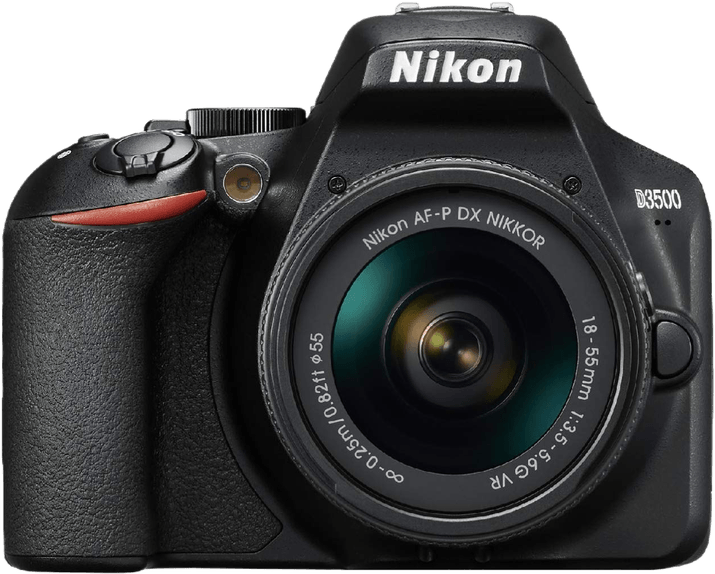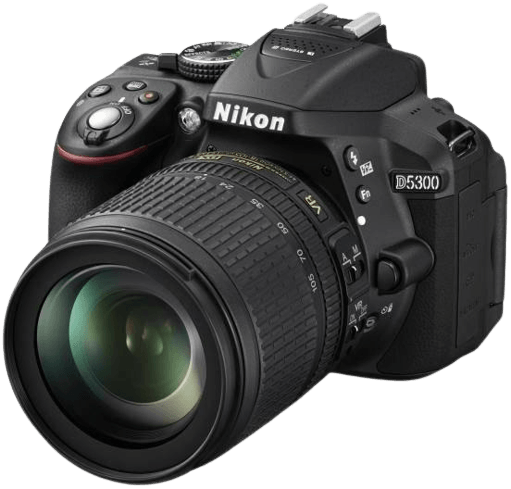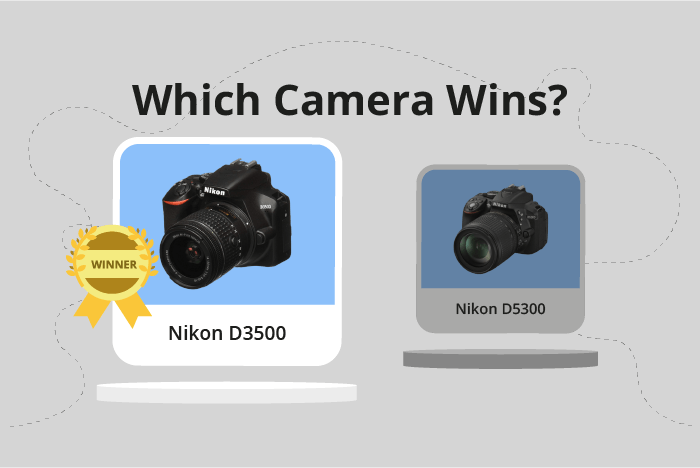Nikon D3500 vs D5300 Comparison
Nikon D3500

Nikon D5300

The Nikon D3500 emerges as the winner with a score of 61/100, while the Nikon D5300 scores slightly lower at 57/100. Both cameras are DSLR models released by Nikon, with the D3500 launched in 2018 and the D5300 in 2013. They share similar dimensions, with the D3500 measuring 124 x 97 x 70mm and the D5300 slightly larger at 125 x 98 x 76mm.
The D3500 outshines the D5300 with its lower launch price of $499.95 compared to the D5300’s $800. However, the D5300 has a lighter weight of 480g (1.06lbs), making it more portable than the D3500 which weighs 615g (1.36lbs).
Taking into account the specifications, the Nikon D3500 offers better value for money, while the Nikon D5300 provides a lighter-weight option for those prioritizing portability.
Nikon D3500 vs D5300 Overview and Optics
Both the Nikon D3500 and Nikon D5300 receive an identical score of 65/100 for optics. They share several common specifications, including a 24-megapixel resolution, 5 fps shooting speed, CMOS sensor type, Expeed 4 processor, APS-C sensor size, Nikon F lens mount, and lack of image stabilization.
The Nikon D3500 edges out the Nikon D5300 with a DXOMARK score of 87 for its sensor, compared to the D5300’s score of 83. This means the D3500 has a slight advantage in image quality, particularly in low light conditions.
On the other hand, the Nikon D5300 has a slightly higher resolution at 24.2 megapixels, compared to the D3500’s 24 megapixels. This minor difference translates to a marginally better image detail and sharpness in the D5300’s output.
Moreover, the Nikon D5300 uses a Nikon F DX lens mount, which is specifically designed for its APS-C sensor size. This offers a wider selection of lenses optimized for the camera’s sensor size, potentially leading to better image quality and performance.
Despite the minor differences, both cameras offer similar optical performance. The Nikon D3500 has a slight advantage in low light conditions with its higher DXOMARK sensor score, while the Nikon D5300 has marginally better image detail and a wider selection of optimized lenses. Ultimately, the choice between the two cameras will depend on individual preferences and priorities in terms of image quality and lens options.
Nikon D3500 vs D5300 Video Performance
The Nikon D5300 emerges as the winner in the video capabilities comparison with a score of 70/100, while the Nikon D3500 has a score of 56/100. Both cameras share some common specifications, such as full HD video resolution with maximum dimensions of 1920×1080 and a maximum video frame rate of 60fps.
The Nikon D5300 outperforms the D3500 due to its built-in time-lapse functionality. This feature allows users to capture stunning time-lapse videos without the need for additional equipment or software. The D5300’s higher video score reflects its superior performance in this area.
On the other hand, the Nikon D3500 does not offer any significant advantages in video capabilities over the D5300. Both cameras share the same maximum video resolution, dimensions, and frame rate, resulting in similar video quality. The D3500’s lower score is due to its lack of time-lapse functionality.
In terms of video capabilities, the Nikon D5300 is the better choice between the two cameras. Its built-in time-lapse feature adds value and versatility to the camera, making it more appealing for users who want to create dynamic video content. The Nikon D3500, while not offering any advantages in this area, remains a solid choice for those seeking a camera with standard video capabilities at an affordable price point. The ultimate decision will depend on the user’s specific needs and preferences.
Nikon D3500 vs D5300 Features and Benefits
The Nikon D3500 emerges as the winner with a feature score of 54/100, while the Nikon D5300 trails behind with a score of 46/100. Both cameras share similarities in specs, such as a lack of touchscreen and the presence of Bluetooth connectivity. However, each camera excels in different areas.
The Nikon D3500’s edge comes from its screen size of 3 inches and a screen resolution of 921,600 dots. While the screen size is smaller than the D5300, it compensates with a higher feature score. The D3500 also offers Bluetooth connectivity, providing an easy way to transfer images to compatible devices.
On the other hand, the Nikon D5300 boasts a larger screen size of 3.2 inches and a higher screen resolution of 1,037,000 dots. In addition, the D5300 has a flip screen, which can be useful for capturing images from different angles. The camera also offers GPS and Wi-Fi capabilities, making it more versatile for location tracking and wireless image transfer. However, it lacks Bluetooth connectivity.
While the D3500 comes out ahead in terms of overall feature score, it is essential to consider individual preferences and needs when choosing between these two cameras. The D3500 may be more suitable for those prioritizing a higher feature score and Bluetooth connectivity, whereas the D5300 may be the better option for users who value a larger screen, flip screen, GPS, and Wi-Fi capabilities.
Nikon D3500 vs D5300 Storage and Battery
The Nikon D3500 outperforms the Nikon D5300 in storage and battery, scoring 48/100 compared to the D5300’s 29/100. Both cameras share some common specifications, such as having a single memory card slot and compatibility with SD, SDHC, and SDXC memory cards. Additionally, both cameras use the same battery type, the EN-EL14a, and neither offers USB charging capabilities.
However, the D3500 surpasses the D5300 in battery life, providing 1550 shots per charge, whereas the D5300 only delivers 600 shots. This significant difference makes the D3500 more suited for extended photography sessions without the need to change batteries frequently.
On the other hand, the D5300 does not have any notable advantages in storage and battery over the D3500. The two cameras share most features in this category, with the D3500 having the upper hand in battery life.
Taking these factors into account, the Nikon D3500 proves to be the superior choice in terms of storage and battery capabilities, primarily due to its extended battery life. The Nikon D5300, while sharing many similarities in this category, falls short in comparison to the D3500.
Alternatives to the Nikon D3500 and D5300
Are you still undecided about which camera is right for you? Have a look at these popular comparisons that feature the Nikon D3500 or the Nikon D5300:

